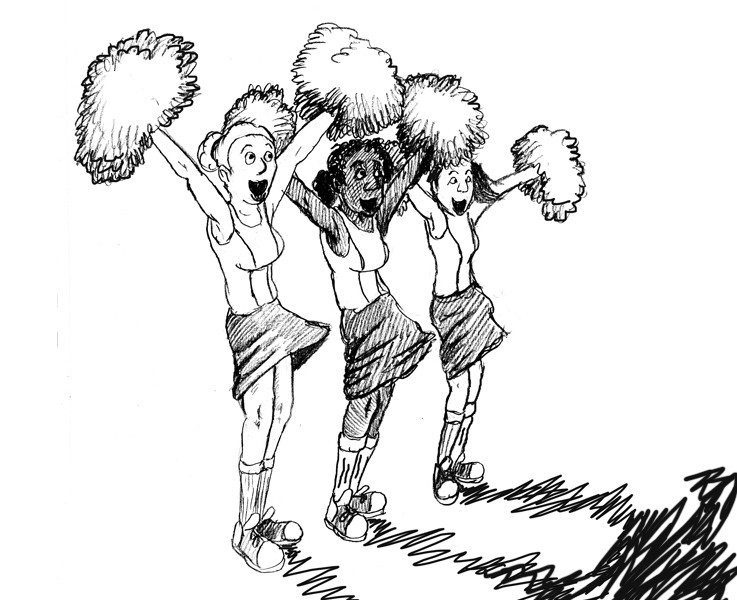Show Some Spirit for the Home Team
Concordia’s Spirit Team Is Back and Better Than Ever
In three lines, more than a dozen sweat-covered female Concordia students drop, bend, and shuffle to LMFAO’s “Party Rock Anthem” right next to the entrance of the athletic complex at the Loyola Campus.
The complex is buzzing with football, basketball and rugby teams taking over the artificial turf field, but the poorly lit pavement will have to do for the the Stinger Spirit squad tonight—there’s no room anywhere else.
It’s chilly and windy; fall’s beginning to set in, but if the girls have noticed it, they aren’t letting on. They’re working up a sweat, decked-out in sweatpants and sweatshirts, but their Spartan dress doesn’t deter the soccer team from casually slowing their pace as they walk by.
Dana Lambert, 20, one of the team’s seasoned vets, snaps at the back-row for being out of sync—the girls are not ones to be distracted. Their eyes are forward, their backs are straight, and you could see the whites of their teeth a hundred metres away.
This is Stinger Spirit.
Getting Better
“We’ve gotten a lot better than last year I think,” said Lambert., who has become the unofficial choreographer, leading and barking orders. It’s no wonder; she has experience back home at a dance studio in Ottawa.
She came to the team in 2009, but it was much different then. Two years ago, the girls didn’t have to try out and no experience was needed to be on the team. This led to frustrating moments and poor performances. Last year the team was so incompetent, the majority of them quit.
“I’m a good competitive person. And when 95 per cent of the people don’t put effort into it, you get fed up,” said Lambert.
“Picture a football team where everyone’s allowed to join. You’re going to have quarterbacks who can’t throw. That’s what we had. […] No practice times, practices weren’t being run properly; our music was screwing up on performance days.”
Since then the power has shifted, however, and Lambert has taken on a bigger role in the group. An unprecedented number of rookies have joined, too; and for the first time in years, tryouts were a necessity to cut the hopefuls down to a 20-woman squad.
The new work ethic is clear: it’s their business to be good. The team practices three times a week, three hours a practice, all for what might not exceed seven performances throughout the year—about the same practice time as the soccer team, but with half the game time.
Among the new recruits is Concordia’s Department of Recreation and Athletics promotions coordinator Samantha Milner, who, like Lambert, has previous experience: gymnastics, hip-hop, aerobics and jazz dancing.
Milner isn’t a bad person to be managing the group—she started her own company, Sassy Sam’s, at the age of 11; it has since sold over $1 million worth of scarves, jewelry and accessories.
Over the years she’s donated thousands of dollars worth of her profits to local charities and continues to help the community by overseeing the Spirit team, helping to schedule practices and performances—a welcome addition from last year’s chaos.
They’re NOT Cheerleaders
Although they now have a full squad of girls cheering on the football team in front the bleachers at Loyola with pom-poms and gold and maroon skirts, Milner stresses they’re not cheerleaders.
“It’s just a different sort,” says Milner. “Girls do dancing and promotions. They can dance and they can tumble. But we just don’t do any lifts or anything like that.”
Even thought the Spirit team is not a cheer squad, Dana Lambert admits there might be a cheerleading stereotype—even if the team doesn’t have time to hang around with the athletic teams.
“We don’t do that. We have practice, then we go to school, then we have practice, then we go to school,” said Lambert.
“If they think the Spirit team’s slutty, then they can think the Spirit team is slutty because we shake our hips instead of run around.”
The stereotype of the classic cheerleader still remains, says women’s issues expert and Concordia professor Angela Ford-Rosenthal.
“I think the stereotype of the cheerleader is someone who is kind of empty-headed, not that bright, focused on their appearance, out to please the men,” said Ford-Rosenthal.
“People might say that it doesn’t really conform to today’s ideas about women. Women shouldn’t be standing there semi-dressed and displaying themselves.
“But they can also be serious students. People make assumptions—that’s the bottom line,” said Ford-Rosenthal. “There’s assumptions made on these women that are probably very far from the truth.”
More Than A Hobby
In fact, the Spirit squad acts more like a community outreach group, taking donations at games and cheering on teams in the bleachers even when they aren’t required to perform, like at ice hockey or baseball games.
For Corbin Girard, 17, however, it’s more than that. She moved to Montreal this fall from Vancouver with few friends in a new city, and she says the transition has made it that much easier because of the Spirit team.
“They have been really open and welcoming; a couple of us are first-years, and they’ve made it really nice for us,” says Girard.
“This is where I met my first friends here. I love all of them. They are so nice and we go and do stuff afterwards.”
As the team practice their routine again—this time flawlessly—it’s hard not to notice similarities to an athletic sports team. Sophomore Emily Richler tries to cool down in the breezy night by fanning herself with the bottom of her shirt, exposing for a second a set of washboard abs.
The next time you’re watching 300 lbs-plus men running at each other, don’t forget that there’s another performance happening a few metres away.
Catch the next performance by the Spirit Team on Oct. 22 at 1 p.m. during the football game at Loyola.


_600_832_s.png)
